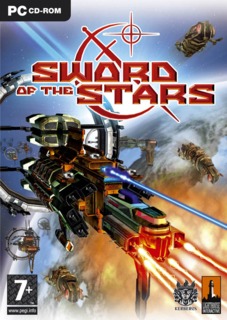Sword of the Stars shows the 4x genre how it's done despite, and indeed because of, its propensity to break the mold.
Basically, 4X games are far more complex than their peers – taking the concept of "difficult to master" and bumping it up to "you could have earned a PhD with the effort you spent learning everything about this game." Complex economic models, detailed diplomatic interactions, and multiple paths to victory are trademarks of 4X. Steep learning curves and exponentially increasing micromanagement as a player's empire grows make the genre fairly off-putting to all but the most hardcore of strategy fans.
And then there was Sword of the Stars, a game that was made by going over every aspect of the 4X genre and asking, "is it fun?" If the answer was yes, it stayed in. As for everything else, it was out the window. The end result is a heavily combat oriented, fully multi-player, turn based strategy which trades in tedious empire management and diplomatic complexities for a depth of strategic warfare and tactical combat rarely seen in games. And it never stops being fun.
As a turn based strategy, it is well built. The interface is exactly as it should be, and provides all the functions and information you need while avoiding bloat. The presentation is top notch, and it breaks the tradition of turn based 4X games being graphically minimalistic. There are 6 races to play as; not your standard samey factions like in similar games, but races that are truly divergent in ship design, play style, and tactics. The most compelling difference between them is their method of faster-than-light travel, which has every single race play the game in a different way. One race follows a node network which restricts movement in exchange for superior speed. Another moves freely but slowly. Another still lacks FTL altogether and must slow-boat out to the distant worlds, but once there can erect teleportation gates to move them to and from any part of their empire instantly – thus playing like the mighty glacier. Despite all their differences, all six races are superbly balanced.
As you explore and colonize the worlds around you, you'll also explore a massive tech tree spanning scores of distinct weapons, armor, shields, and various other technologies. This tech tree is randomized every game, causing each one to be slightly different and sometimes forcing you to come up with creative solutions to get around lacking a technology you are used to having, or hope you can reverse-engineer it from another player. From the weapons and ship technology you research, you then design the ships you will be building. There are tons of sections that can be used in a ship design which offer different functionalities, and how you design the ship will impact your tactics later. One thing that makes Sword of the Stars amazing from a cinematic standpoint are the sheer number of guns on each ship. The smallest ships you'll design will be able to fit half a dozen turrets, while the largest can have close to one hundred. Needless to say, these are extremely satisfying to watch open fire.
Which brings me to the combat. Conflicts come in two flavors in Sword of the Stars: automatic and manual. For battles which are a sure win or loss, small encounters such as two scouts meeting, or for those who simply do not want to break up the flow of the turn based half of the game, any battle can be auto-resolved. For everything else, you can personally take control and fight in a well rendered, fully 3D real time battle – and this is where the game truly shines. Here, ships move about realistically and everything is calculated in Newtonian physics. From the moment a projectile leaves the barrel, its speed and trajectory alone determine what it hits. Any given shot could very well pass right through a hole in the target ship, or bounce of their armor if it hits at a bad angle (and then proceed to hit another passing ship). One of the most remarkable results of this game mechanic is the fact that it utterly precludes the feeling of a "spreadsheet war" found in other strategy games. While units in such games are little more than statistical numbers and decide battles based solely on armor and power, it is not so in Sword of the Stars. Everything from ship speed, turning speed, turret firing arcs, range, and most importantly player tactics come into play when deciding an outcome. This adds an entire tactical level of strategy to the game. More than this, being able to see your designs truly come alive gives every single weapon and ship a personality, painting a living breathing game world – and will inspire you to explore the tech tree to try out each and every weapon for yourself.
All in all, though it may be a bit different from the standard 4X fare, Sword of the Stars is easily one of the best strategy games out there. Veterans of 4X may find themselves disappointed by the relative simplicity of the economic model and lack of things to do with your empire, but make no mistake – Sword of the Stars is as complex as any other 4X; anything it lacks in empire management is instead made up for in the combat. There are very few strategy games that so perfectly merge the three levels of warfare – Strategic, Operational, and Tactical. New players will undoubtedly feel lost at first, but don't give up. By its very nature this game takes a fair amount of time to get into, but those who put up the effort to do so will find the game endlessly rewarding and anyone who loves strategy and tactics, or space opera, absolutely must give this game a try.

